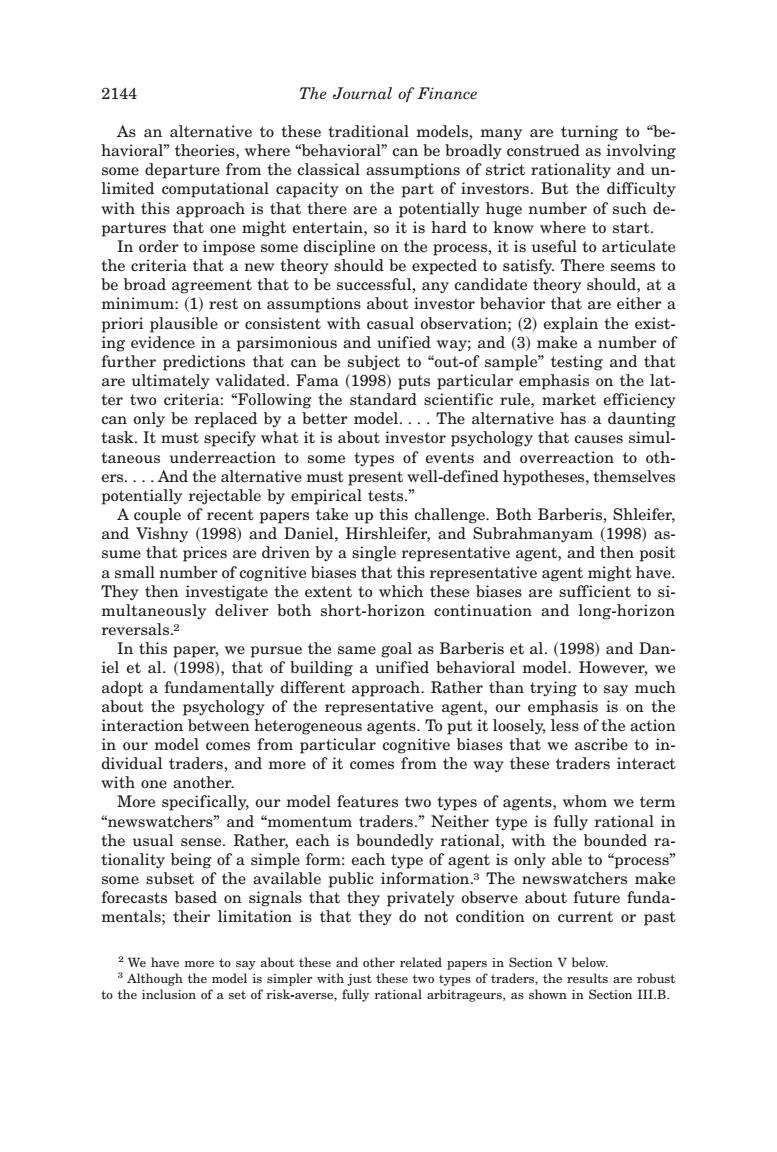正在加载图片...

2144 The Journal of Finance As an alternative to these traditional models,many are turning to"be- havioral"theories,where "behavioral"can be broadly construed as involving some departure from the classical assumptions of strict rationality and un- limited computational capacity on the part of investors.But the difficulty with this approach is that there are a potentially huge number of such de- partures that one might entertain,so it is hard to know where to start. In order to impose some discipline on the process,it is useful to articulate the criteria that a new theory should be expected to satisfy.There seems to be broad agreement that to be successful,any candidate theory should,at a minimum:(1)rest on assumptions about investor behavior that are either a priori plausible or consistent with casual observation;(2)explain the exist- ing evidence in a parsimonious and unified way;and(3)make a number of further predictions that can be subject to "out-of sample"testing and that are ultimately validated.Fama (1998)puts particular emphasis on the lat- ter two criteria:"Following the standard scientific rule,market efficiency can only be replaced by a better model....The alternative has a daunting task.It must specify what it is about investor psychology that causes simul- taneous underreaction to some types of events and overreaction to oth- ers....And the alternative must present well-defined hypotheses,themselves potentially rejectable by empirical tests." A couple of recent papers take up this challenge.Both Barberis,Shleifer, and Vishny (1998)and Daniel,Hirshleifer,and Subrahmanyam (1998)as- sume that prices are driven by a single representative agent,and then posit a small number of cognitive biases that this representative agent might have. They then investigate the extent to which these biases are sufficient to si- multaneously deliver both short-horizon continuation and long-horizon reversals.2 In this paper,we pursue the same goal as Barberis et al.(1998)and Dan- iel et al.(1998),that of building a unified behavioral model.However,we adopt a fundamentally different approach.Rather than trying to say much about the psychology of the representative agent,our emphasis is on the interaction between heterogeneous agents.To put it loosely,less of the action in our model comes from particular cognitive biases that we ascribe to in- dividual traders,and more of it comes from the way these traders interact with one another. More specifically,our model features two types of agents,whom we term “newswatchers'”and“momentum traders..”Neither type is fully rational in the usual sense.Rather,each is boundedly rational,with the bounded ra- tionality being of a simple form:each type of agent is only able to "process" some subset of the available public information.3 The newswatchers make forecasts based on signals that they privately observe about future funda- mentals;their limitation is that they do not condition on current or past 2 We have more to say about these and other related papers in Section V below. 3 Although the model is simpler with just these two types of traders,the results are robust to the inclusion of a set of risk-averse,fully rational arbitrageurs,as shown in Section III.B.As an alternative to these traditional models, many are turning to “behavioral” theories, where “behavioral” can be broadly construed as involving some departure from the classical assumptions of strict rationality and unlimited computational capacity on the part of investors. But the difficulty with this approach is that there are a potentially huge number of such departures that one might entertain, so it is hard to know where to start. In order to impose some discipline on the process, it is useful to articulate the criteria that a new theory should be expected to satisfy. There seems to be broad agreement that to be successful, any candidate theory should, at a minimum: ~1! rest on assumptions about investor behavior that are either a priori plausible or consistent with casual observation; ~2! explain the existing evidence in a parsimonious and unified way; and ~3! make a number of further predictions that can be subject to “out-of sample” testing and that are ultimately validated. Fama ~1998! puts particular emphasis on the latter two criteria: “Following the standard scientific rule, market efficiency can only be replaced by a better model. . . . The alternative has a daunting task. It must specify what it is about investor psychology that causes simultaneous underreaction to some types of events and overreaction to others. . . . And the alternative must present well-defined hypotheses, themselves potentially rejectable by empirical tests.” A couple of recent papers take up this challenge. Both Barberis, Shleifer, and Vishny ~1998! and Daniel, Hirshleifer, and Subrahmanyam ~1998! assume that prices are driven by a single representative agent, and then posit a small number of cognitive biases that this representative agent might have. They then investigate the extent to which these biases are sufficient to simultaneously deliver both short-horizon continuation and long-horizon reversals.2 In this paper, we pursue the same goal as Barberis et al. ~1998! and Daniel et al. ~1998!, that of building a unified behavioral model. However, we adopt a fundamentally different approach. Rather than trying to say much about the psychology of the representative agent, our emphasis is on the interaction between heterogeneous agents. To put it loosely, less of the action in our model comes from particular cognitive biases that we ascribe to individual traders, and more of it comes from the way these traders interact with one another. More specifically, our model features two types of agents, whom we term “newswatchers” and “momentum traders.” Neither type is fully rational in the usual sense. Rather, each is boundedly rational, with the bounded rationality being of a simple form: each type of agent is only able to “process” some subset of the available public information.3 The newswatchers make forecasts based on signals that they privately observe about future fundamentals; their limitation is that they do not condition on current or past 2 We have more to say about these and other related papers in Section V below. 3 Although the model is simpler with just these two types of traders, the results are robust to the inclusion of a set of risk-averse, fully rational arbitrageurs, as shown in Section III.B. 2144 The Journal of Finance